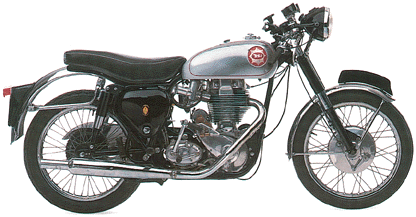 My bike had a superficial resemblance to the bike on
the right with the following exceptions:
My bike had a superficial resemblance to the bike on
the right with the following exceptions:The morning after the first night before I turned up at Jan's house in City Road in Cambridge on my 1952 A7 twin cylinder 500. I carried her off to Thetford Warren in a cloud of oil fumes at a steady 40 mph, and we did those deeply meaningful pair-bonding things that people do on the morning after. Like throwing huge quantities of leaves at each other.
No picture of this bike survives. In 1974 it was already 22 years old, and life had not been kind to it.
 My bike had a superficial resemblance to the bike on
the right with the following exceptions:
My bike had a superficial resemblance to the bike on
the right with the following exceptions:
I bought the bike for £55 from a man who saw me coming. The front forks pulled to the left when the brakes were applied, and the front wheel shuddered violently. The clutch slipped, making acceleration difficult, but the bike would cruise all day at a steady 40 mph. It even reached 60 mph on a couple of occasions when I felt suicidal. Oil bubbled out of the head gasket, so that in traffic I would be enveloped in a cloud of oil fumes. The magneto seemed to make sparks, but didn't seem to know about the battery or the rest of the electrical system. It consumed almost as much oil as petrol. Other than these few minor problems (which I never did anything about) the bike was fine. It was sturdy. I once rode off without undoing the hardened steel chain around the front wheel. There was a mighty explosion, bits of chain flew in all directions, but the spokes were undamaged.
After our leafy frolic in Thetford Forest, I rode the A7 up to Yorkshire to meet Jan's parents. They were impressed with the mouldering mountain of baked oil and dirt that leaked oil on their patio flagstones. Jan and I insinuated, broadly hinted, and even came close to suggesting, that their only daughter was going to sit on the back of this deathtrap all the way to Dumfries in Scotland, where Jan's Granddad lived. He was a feisty old guy who had survived the trenches in the First World War, only to have the misfortune to be in Singapore when the Japanese took the place. He dug a huge hole in the grounds of his house and buried his car in it rather than let the Japanese have it. He then went on to take part in the building of the Burma Railway, and survived that too (i.e. The Bridge on the River Kwai).
The journey began badly: we almost ran into a ditch when I braked to turn onto the A1. At Scotch Corner we took the little road that runs over the hills through Barnard Castle and Teesdale to Gretna Green. It runs through some of the wildest and bleakest country in England. It is a country where sheep wear wellington boots.
The bike was horrible. The vibrating forks threatened to throw us off at the bottom of every downslope, and the clutch slipped like mad going up the other side. As we clawed up to the highest point of the North Pennines, shrouded in wet grey cloud, dodging sheep on the road (it was too wet to expect them to stand on the moor) the back tyre went.
We had no tools, and no way to move a hugely heavy bike with a flat tyre, so we sat down in the rain and mist and waited. Eventually a farmer came by with a horsebox and we struggled and heaved to get the A7 in. The farmer and his wife were very kind people. He helped me to remove the tyre, and their daughter ran me 10 miles to the nearest garage. It was late afternoon when we set off. We had to get to Dumfries before dark, because I had no lights. I have a vivid memory of looking down from the foothills of the Pennines, out over Carlisle, with the sun sinking low in the West.
I don't remember the return journey back to Cambridge. Nothing happened. Nothing happened the second time I took the bike up to Edinburgh to visit my parents. I borrowed my Dad's tools, stripped the forks, and there was nothing wrong that a complete replacement of every part wouldn't fix. I rode the bike back to Cambridge, covering the 400 miles in 10 hours at a steady 40 mph.
When the time came to MOT the bike I tried to find the address on the current MOT. I figured that if they had MOTed it once, they might do it again. If "Brown's of Burwell" had ever existed, it certainly didn't exist when I tried to find it ... and it wasn't as if Burwell was a big place. Old gaffers in the pub were scratching their heads trying to remember "Brown's of Burwell".
I had the A7 MOTed at one of the bike shops in Cambridge. It isn't often that an examiner has to use extension sheets to cover all the points where a vehicle has failed.
There wasn't much point in having it repaired, because my Australian motorbike licence had expired and I needed to resit my test. I needed a 125 cc or smaller. I sold the bike without an MOT to a young guy for £50. A week later a policeman called wanting to know where the bike was - the new owner had used the metal "engine protector" to gouge the side of a lady's car, and ridden off in a hurry.
I can believe this, apart from the part where he rides off in a hurry.
Back to Home Page
Copyright © Colin Low 1997